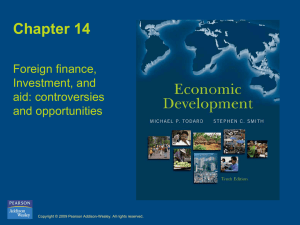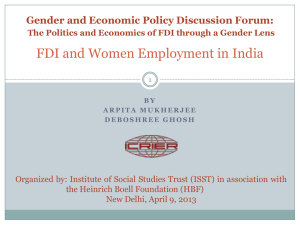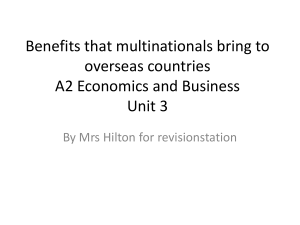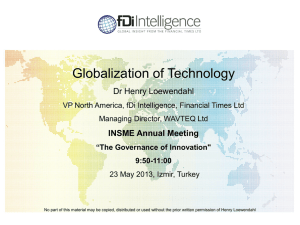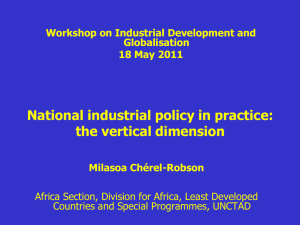The fDi Report 2013: Global trends
advertisement
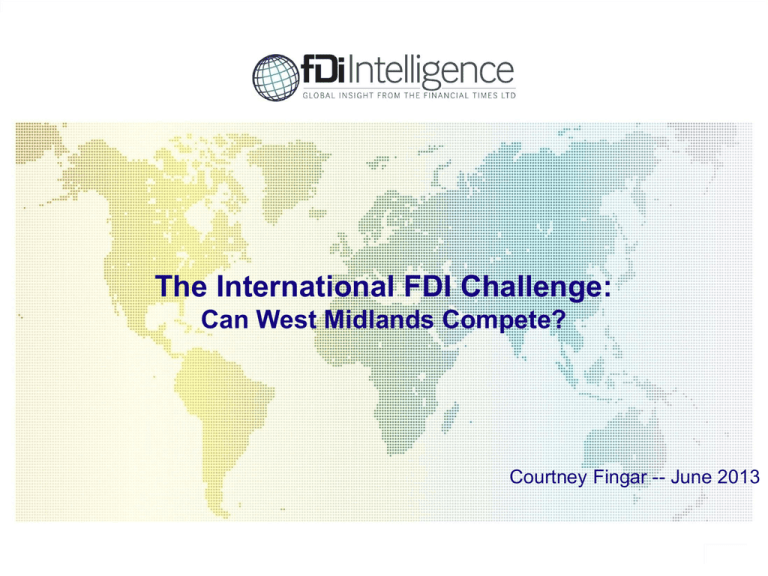
The International FDI Challenge: Can West Midlands Compete? Courtney Fingar -- June 2013 1 The big picture • Global macro situation the past few years: recovery versus upheaval • Liquidity returning but resources crunch (real or imagined) continues: food, oil, water, land, rare earths • M&A grew much faster in recovery, but tends to be more volatile than greenfield investment • Economic uncertainty is making corporate investors more cautious • Challenging time for global FDI with sharp decline in many markets in 2011-12 2 The fDi Report 2013: Global trends • The slow recovery in greenfield FDI in 2011 ground to a halt in 2012, with the second biggest decline in FDI since the start of the world recession. All global regions experienced a decline in FDI. • The main exceptions were Chile, Spain, Indonesia, Poland and Oman • Chile replaced Brazil this year as the star performer, driven by sustained 5%plus GDP growth rates and an influx of renewable energy investments • BRICs: With Brazil struggling to regain growth, Russia muddling along, and growth levels in China and India falling, BRICs market share of global FDI is declining (now 17%) • FDI forecast for 2013 is pretty grim. World economic growth is expected to slow and with continued political and economic uncertainty around the world a substantial decline in FDI can be expected in 2013 of the magnitude of 20%. 3 4 The fDi Report 2013: Europe trends • The number of FDI projects into Europe declined in 2012, mirroring global trends. 20% drop in project numbers • The UK performed slightly better than Europe as a whole, posting an 8% decline in projects but increasing its market share of FDI into the region to 20.87% in 2012, the highest of any European country • Spain and Poland were the only top European countries to see an increase in investments • ICT is the largest FDI sector for Europe, overtaking business and financial services 5 FDI in Europe, 2012: Change from 2011 (Top 10 destination countries) 6 Top source countries, Europe 2012 Top sectors for FDI into Europe, 2012 7 The challenge for investment promotion agencies • Lower-risk, lower-cost globalisation strategies pursued by companies postrecession: JVs, alliances, partnerships • Difficulty for IPAs not equipped to promote or facilitate these types of investments (more matchmaking) • Expansions becoming a more important part of FDI: in 2011, nearly 1 in 5 projects was expansion of an existing facility rather than investment in a new site • A substantial decline in global FDI is predicted for 2013. With fewer new projects on offer, expansions or co-locations will be more important than ever. This makes investor aftercare essential to FDI success. 8 West Midland’s prospects • Advantages: Being in Europe’s top FDI country, and within a region of that country with strong fundamentals for manufacturing and technology, as well as good logistics, provides an advantage. The UK automotive sector is thriving, driven by activity in the Midlands. Transport (a strong point for the region) is a growing sector internationally. Active FDI promotion effort underway • Disadvantages: Name recognition poor outside UK; outdated reputation in some areas; differentiation between east and west Midlands and among the key cities difficult; co-ordination or competition between constituents parts post-RDA? Birmingham as a draw, or just a hoover? • Who’s keen? fDi Markets tracks the US, Germany, France, India and Sweden as the top source markets for inward investment into the region 9 Contact For more information please feel free to contact me: Courtney Fingar Editor, fDi Magazine fDi Intelligence The Financial Times Ltd Tel: (+44)(0)20 7775 6365 Email: Courtney.Fingar@FT.com Web: www.fdiintelligence.com Twitter: @CourtneyFingar 10



